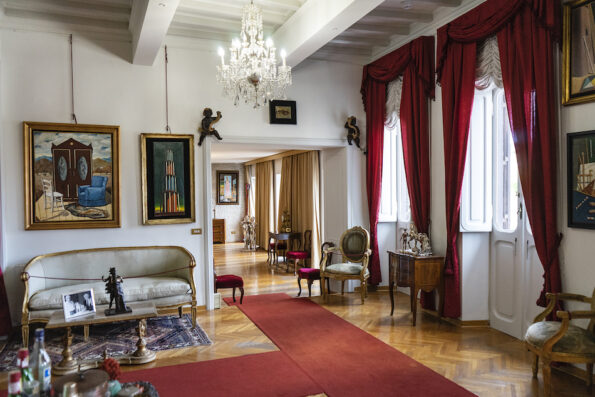Search
To search for an exact match, type the word or phrase you want in quotation marks.
A*DESK has been offering since 2002 contents about criticism and contemporary art. A*DESK has become consolidated thanks to all those who have believed in the project, all those who have followed us, debating, participating and collaborating. Many people have collaborated with A*DESK, and continue to do so. Their efforts, knowledge and belief in the project are what make it grow internationally. At A*DESK we have also generated work for over one hundred professionals in culture, from small collaborations with reviews and classes, to more prolonged and intense collaborations.
At A*DESK we believe in the need for free and universal access to culture and knowledge. We want to carry on being independent, remaining open to more ideas and opinions. If you believe in A*DESK, we need your backing to be able to continue. You can now participate in the project by supporting it. You can choose how much you want to contribute to the project.
You can decide how much you want to bring to the project.

No one lives in the Piazza di Spagna in Rome. Tourists sit on the stairs of the plaza and carabinieri routinely stop them from sitting there. The tourists, after being expelled from their ephemeral rest area, usually go to Via Condotti to check out the upscale-brand stores and their fancy shop windows, now converted into pop art street museums.
Nobody lives in Piazza di Spagna, but if we conjugate the verb into the past tense things change. The poet John Keats lived and died there, in a small room overlooking the plaza, and, between 1948 and 1978 the painter Giorgio de Chirico was also a resident. I visited both houses with the photographer Lisbeth Salas to integrate them into our collection of artists’ houses/museums with which we will do something soon. Giorgio de Chirico’s, to my delight, seemed much more like a house than a museum.
In the homes of painters, the center of the visit is the studio where they work. The curators of the museum or those who have devised the route for the visitors know this. The public wants, above all, to see dried-out brushes, worn-out oil tubes that have been squeezed to the last drop, and wooden palettes smeared with all the colors of the rainbow. We will never know if those were really the brushes the artist used, nor if they habitually bought tubes of that brand of paint. It is more likely that those who dusted off the house to elevate it to the noble heights of a museum rescued old materials from a school of fine arts from past decades. We don’t care, though, because we go there with the same devotion as to a basilica, where the veracity of the saint’s relics is never questioned.
In the case of Giorgio De Chirico, the visit to his Roman home begins in the hall of the apartment and continues through the living rooms and dining room, as the bedroom and study are on the upper floor. We put ourselves in the hands of the guide, whose name is Valeria, and enter the first room, lavish and with a well-preserved parquet that I envy, since I am the owner of a humble laminated, imitation-wooden floor. I say “first room” because there is more than one, since the painter united several apartments in that 17th-century palazzo to make what today could be called in Italian casoplone, if one chose to use such a word.
In my memory, the house still seems huge to me, and I think it was because I looked at it as if I were eight years old. Entering the De Chirico living room was like going back to a time that will never return, like visiting the homes of respectable couples with my parents. Many will say “Thank goodness those times won’t return,” but perhaps if your parents’ friends were Giorgio and Isabel de Chirico instead of Ministry of Finance officials, well, it wouldn’t be so bad for them to return. Since my parents’ friends were not the De Chiricos, they did not have oil paintings in their salons with the works from Giorgio’s metaphysical stage, nor did they have many sketches of horses. According to what our guide Valeria tells us, De Chirico liked drawing horses since he was a child, and so it is an important part of his graphic universe.
Despite not being the De Chiricos, my parents’ friends did have a similarly large and heavy table, probably made of alpaca, just like Giorgio and Isabel. People smoked a lot in those days, so colored glass or metal ashtrays were common in the living rooms of such houses. They also all had, of course, a TV in the living room. The De Chiricos had a big-ass SONY arranged in front of a window full of curtains. Valeria tells us that the painter watched it but always with the sound off. I understand the habit, as unwanted human voices are much worse than any ambient noise. As the protagonist of the living room, next to the dining room, the cabinet-bar stands out. The guide assures that it is authentic, that its martini shaker and its bottles of Campari and Gibò aperitif are from the era. Like good Italians, the De Chiricos were fond of the bitterness of drinks that they ipso facto turned into festive cocktails, judging by the number of Spritzs that are served daily on the streets of Rome.
If, as a child, my parents had taken me to the De Chirico house, after looking at the paintings from all the stages of the painter and touching all the objects that were there (from a small reproduction of Michelangelo’s Pietà to several bunches of marble grapes), I would have started to get bored with adult conversation. Perhaps I would have started fiddling with one of the many parchment-shaded floor lamps in the living rooms. Confronted with the anger of my parents, I would have sat down with a grumpy face, and Giorgio would surely have understood that I was bored to death. Taking pity on the bambina spagnola, he would have offered me a film to watch to keep me entertained, because giving me permission to graffiti his studio wouldn’t even have crossed his mind.
Then he would have asked me to accompany him to the second floor, to the couple’s bedroom, where the great SABA video in VHS format still rests (my parents were unlucky and chose the Beta, which was quickly losing popularity in video stores), and I would have put a movie by Topo Gigio or Adriano Celentano in the video player, labeled with Accendere/Spengere on a self-adhesive label above the power key, and Togliere cassetta on the key that shows the icon for ejecting the video, that is, the Eject button we have come to know so well since the 1970s. The gesture of translating what the signs indicate into their language makes the De Chiricos akin to my parents and their friends, at that time still oblivious to contemporary signage, and immerses me completely in bittersweet nostalgia, a trait that by definition characterizes this feeling.
To drink, for he surely would have offered me something, I would have asked him for an orange Trinaranjus, or a lemon Fanta, but they didn’t have those brands. Instead he would have given me a Granini de pesca, a name that would have disturbed me until I found out it meant “peach,” and I would have accepted it just as happily.

De Chirico’s family living room © Lisbeth Salas

Mercedes Cebrián (Madrid, 1971). She writes poetry, fiction, essays and chronicles. She collaborates with the magazine “Letras Libres”, with the newspaper “The Objective” and with the supplements “El Viajero” and “Babelia” of El País and “Cultura/s” of La Vanguardia. Her latest book is the chronicle “Cocido y violonchelo” (Lit Random House, 2022). She has been writer-in-residence at the Spanish Academy in Rome, at the MALBA museum in Buenos Aires and at the Civitella Ranieri Center, among other institutions. She holds a Master’s degree in Hispanic Studies from the University of Pennsylvania (USA). During 2018 she was the guest editor of the publishing imprint Caballo de Troya (Penguin Random House). In 2022 she directed and presented the Classical Radio program “Música de principio a fin”.
Portrait © Lisbeth Salas.
"A desk is a dangerous place from which to watch the world" (John Le Carré)